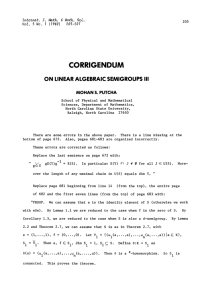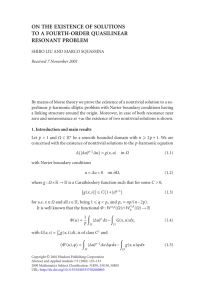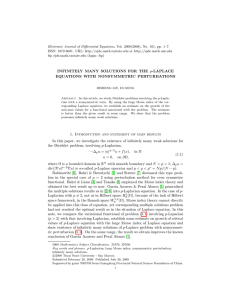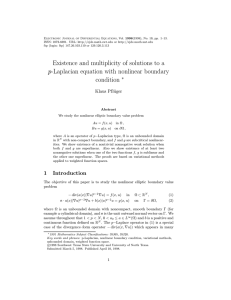Document 10747541
advertisement
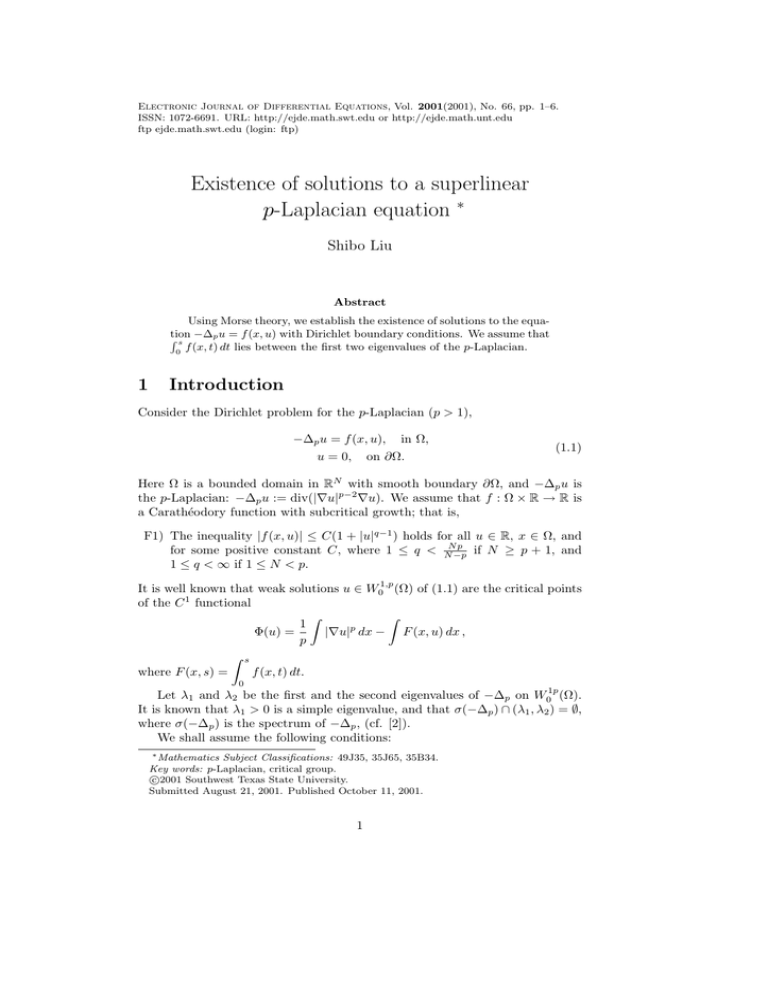
Electronic Journal of Differential Equations, Vol. 2001(2001), No. 66, pp. 1–6.
ISSN: 1072-6691. URL: http://ejde.math.swt.edu or http://ejde.math.unt.edu
ftp ejde.math.swt.edu (login: ftp)
Existence of solutions to a superlinear
p-Laplacian equation ∗
Shibo Liu
Abstract
Using Morse theory, we establish the existence of solutions to the equation
R s −∆p u = f (x, u) with Dirichlet boundary conditions. We assume that
f (x, t) dt lies between the first two eigenvalues of the p-Laplacian.
0
1
Introduction
Consider the Dirichlet problem for the p-Laplacian (p > 1),
−∆p u = f (x, u), in Ω,
u = 0, on ∂Ω.
(1.1)
Here Ω is a bounded domain in RN with smooth boundary ∂Ω, and −∆p u is
the p-Laplacian: −∆p u := div(|∇u|p−2 ∇u). We assume that f : Ω × R → R is
a Carathéodory function with subcritical growth; that is,
F1) The inequality |f (x, u)| ≤ C(1 + |u|q−1 ) holds for all u ∈ R, x ∈ Ω, and
p
for some positive constant C, where 1 ≤ q < NN−p
if N ≥ p + 1, and
1 ≤ q < ∞ if 1 ≤ N < p.
It is well known that weak solutions u ∈ W01,p (Ω) of (1.1) are the critical points
of the C 1 functional
Z
Z
1
Φ(u) =
|∇u|p dx − F (x, u) dx ,
p
Z s
where F (x, s) =
f (x, t) dt.
0
Let λ1 and λ2 be the first and the second eigenvalues of −∆p on W01p (Ω).
It is known that λ1 > 0 is a simple eigenvalue, and that σ(−∆p ) ∩ (λ1 , λ2 ) = ∅,
where σ(−∆p ) is the spectrum of −∆p , (cf. [2]).
We shall assume the following conditions:
∗ Mathematics Subject Classifications: 49J35, 35J65, 35B34.
Key words: p-Laplacian, critical group.
c
2001
Southwest Texas State University.
Submitted August 21, 2001. Published October 11, 2001.
1
2
Existence of solutions
EJDE–2001/66
F2) There exist r > 0, λ̄ ∈ (λ1 , λ2 ) such that |u| ≤ r implies
λ1 |u|p ≤ pF (x, u) ≤ λ̄|u|p ,
F3) There exist θ > p, M > 0 such that |u| ≥ M implies
0 < θF (x, u) ≤ uf (x, u).
Now, we are ready to state our main result.
Theorem 1.1 Assume (F1), (F2), and (F3). Then (1.1) has a nontrivial weak
solution in W01,p (Ω).
There are many papers devoted to the existence of solutions of (1.1); see
for example [1, 4, 5]. In these papers, the main tool is the minmax argument.
However, it seems difficult to use the minmax argument in our situation. Thus
we will use a different approach: Morse theory [3]. To the best of our knowledge,
[7] is the only work using Morse theory to obtain the solvability of p-Laplacian
equations. Our work is motivated by [7].
2
Proof of main theorem
In this section we give the proof of Theorem 1.1. Let E denote the Sobolev
space W01,p (Ω), and k.k denote the norm in E. For Φ a continuously Fréchet
differentiable map from E to R, let Φ0 (u) denote its Fréchet derivative.
As stated in Section 1, weak solutions u ∈ W01,p (Ω) of (1.1) are the critical
points of the C 1 functional
Z
Z
1
p
|∇u| dx − F (x, u) dx .
Φ(u) =
p
We will try to find a nontrivial critical point of the functional Φ. First we state
the following lemmas.
Lemma 2.1 Under conditions (F1) and (F3), the functional Φ satisfies the
Palais-Smale condition.
Proof Assume (un ) ⊂ E, |Φ(un )| ≤ B for some B ∈ R, and Φ0 (un ) → 0. Let
d := supn Φ(un ). Then by (F3) we have
θd + kun k
≥ θΦ(un ) + hΦ0 (un ), un i
Z
θ
= ( − 1)kun kp −
[θF (x, un ) − f (x, un )un ]
p
|un |≥M
Z
−
[θF (x, un ) − f (x, un )un ]
|un |≤M
Z
θ
p
≥ ( − 1)kun k −
[θF (x, un ) − f (x, un )un ]
p
|un |≤M
θ
≥ ( − 1)kun kp − D, for some D ∈ R.
p
EJDE–2001/66
Shibo Liu
3
Thus (un ) is bounded in E. Up to a subsequence, we may assume that un * u
in E. Now because of condition (F1), a standard argument shows that un → u
in E and the proof is complete.
♦
Let V = span φ1 be the one-dimensional eigenspace associated to λ1 , where
φ1 > 0 in Ω and kφ1 k = 1. Taking a subspace W ⊂ E complementing V , that
is E = V ⊕ W . Obviously the genus of W \0 satisfies γ(W \0) ≥ 2. Therefore,
by the variational characterization of λ2 , for ∀u ∈ W ,
Z
Z
p
|∇u| ≥ λ2 |u|p .
Lemma 2.2 Under Assumption (F2), the functional Φ has a local linking at
the origin with respect to E = V ⊕ W . That is, there exists ρ > 0, such that
Φ(u) ≤ 0, u ∈ V, kuk ≤ ρ,
Φ(u) > 0, u ∈ W, 0 < kuk ≤ ρ.
The proof of this lemma can be found in [7, Lemma 3.3].
For a C 1 -functional Φ : E → R and u an isolate critical point of Φ, Φ(u) = c,
we define the critical group of Φ at u as
Cq (Φ, u) := Hq (Φc , Φc \{u}).
Where Hq (X, Y ) is the q-th homology group of the topological pair (X, Y ) over
the ring Z.
Since dim V = 1 < +∞, from Lemma 2.2 and Theorem 2.1 in [6], we have
Lemma 2.3 Under assumption (F2), 0 is a critical point of Φ and C1 (Φ, 0) 6=
0.
To find a nontrivial critical point of Φ, we investigate the behavior of Φ near
infinity.
Lemma 2.4 Under Assumption (F3), there exists a constant A > 0 such that
Φa ' S ∞ ,
for a < −A,
where S ∞ is the unit sphere in E.
Proof Integrating on the inequality of (F2), we obtain a constant C1 > 0 such
that
F (x, t) ≥ C1 |t|θ ,
for |t| ≥ M.
Thus, for u ∈ S ∞ , we have Φ(tu) → −∞, as t → +∞. Set
1
M |Ω| max |f (x, u)| + 1 .
A := 1 +
p
Ω̄×[−M,M ]
4
Existence of solutions
EJDE–2001/66
Using (F3) we obtain
Z
Z
1
F (x, v) −
vf (x, v)
p
Z
Z
Z
Z
1
1
=
F (x, v) +
F (x, v) −
vf (x, v) −
vf (x, v)
p |v|≥M
p |v|≤M
|v|≥M
|v|≤M
Z
Z
Z
1 1
1
≤
−
vf (x, v) +
F (x, v) −
vf (x, v)
θ p
p |v|≤M
|v|≥M
|v|≤M
Z
1 1
1
≤
−
vf (x, v) + 1 +
M |Ω| max |f (x, u)|
θ p
p
Ω̄×[−M,M ]
|v|≥M
Z
1 1
≤
−
vf (x, v) + A − 1.
θ p
|v|≥M
For a < −A and
Φ(tu) =
|t|p
−
p
Z
F (x, tu) ≤ a,
(u ∈ S ∞ ),
we have
d
Φ(tu)
dt
Z
= hΦ0 (tu), ui = |t|p−2 t − uf (x, tu)
Z
Z
o
pn
1
≤
F (x, tu) −
tuf (x, tu) + a
t
p
Z
n
o
p 1 1
≤
( − )
tuf (x, tu) + A − 1 + a
t θ p |tu|≥M
Z
o
pn 1 1
≤
( − )
tuf (x, tu) − 1
t θ p |tu|≥M
Z
o
pn 1 1
≤
( − )C1 θ
|tu|θ − 1 < 0.
t θ p
|tu|≥M
By the Implicit Function Theorem, there is a unique T ∈ C(S ∞ , R) such that
Φ(T (u)u) = a,
For u 6= 0, set T̃ (u) =
1
u
kuk T ( kuk ).
∀u ∈ S ∞ .
Then T̃ ∈ C(E\0, R) and for all u ∈ E\0,
Φ(T̃ (u)u) = a. Moreover, if Φ(u) = a, then T̃ (u) = 1.
We define a function T̂ : E\0 → R as
(
T̃ (u), if Φ(u) ≥ a,
T̂ (u) :=
1,
if Φ(u) ≤ a.
Since Φ(u) = a implies T̃ (u) = 1, we conclude that T̂ ∈ C(E\{0}, R).
Finally we set η : [0, 1] × (E\0) → E\0 as
η(s, u) = (1 − s)u + sT̂ (u)u.
EJDE–2001/66
Shibo Liu
5
It is easy to see that η is a strong deformation retract from E\0 to Φa . Thus
Φa ' E\0 ' S ∞ and present proof is complete.
♦
We also use the following topological result,which was proved by Perera [8].
Lemma 2.5 Let Y ⊂ B ⊂ A ⊂ X be topological spaces and q ∈ Z. If
Hq (A, B) 6= 0
and
Hq (X, Y ) = 0
or
Hq−1 (B, Y ) 6= 0 .
then
Hq+1 (X, A) 6= 0
Now we can prove the main theorem.
Proof of Theorem 1.1 By Lemma 2.1, Φ satisfies the Palais-Smale condition.
Note that Φ(0) = 0, from [3] Chapter I, Theorem 4.2, there is a ε > 0, such that
H1 (Φε , Φ−ε ) = C1 (Φ, 0) 6= 0.
By Lemma 2.4, for a < −A (A is as in the lemma) we have Φa ' S ∞ . Since
dim E = +∞,
H1 (E, Φa ) = H1 (E, S ∞ ) = 0.
So that Lemma 2.5 yields
H2 (E, Φε ) 6= 0 or
H0 (Φ−ε , Φa ) 6= 0.
It follows that Φ has a critical point u for which
Φ(u) > ε or
− ε > Φ(u) > a .
Therefore, u is a nonzero critical point of Φ, and (1.1) has a nontrivial solution.
Remark Result similar to Lemma 2.4 has been proved (for p = 2) in [9] and
[3], under the additional conditions
f ∈ C 1 (Ω × R, R),
f (x, 0) =
∂f (x, t) = 0.
∂t
t=0
From these two references, we have obtained the motivation for this paper.
References
[1] A. R. El Amrouss & M. Moussaoui, Minimax principles for critical-point
theory in applications to quasilinear boundary-value problems, Electron. J.
Diff. Eqns.,, 2000(2000), No. 18, 1–9.
[2] A. Anane & N. Tsouli, On the second eigenvalue of the p-Laplacian, Nonlinear Partial Differential Equations, Pitman Research Notes 343(1996), 1–9.
6
Existence of solutions
EJDE–2001/66
[3] K. C. Chang, Infinite dimensional Morse theory and multiple solution problems, Birkhäuser, Boston, 1993.
[4] D. G. Costa & C. A. Magalhães, Existence results for perturbations of the
p-Laplacian, Nonlinear Analysis, 24(1995), 409–418.
[5] X. L. Fan & Z. C. Li, Linking and existence results for perturbations of the
p-Laplacian, Nonlinear Analysis, 42(2000), 1413-1420.
[6] J. Q. Liu, The Morse index of a saddle point, Syst. Sc. & Math. Sc., 2(1989),
32-39.
[7] J. Q. Liu & J. B. Su, Remarks on multiple nontrivial solutions for quasilinear resonant problems, J. Math. Anal. Appl., 258(2001), 209-222.
[8] K. Perera, Critical groups of critical points produced by local linking with
applications, Abstract and Applied Analysis, 3(1998), 437-446.
[9] Z. Q. Wang, On a superlinear elliptic equation, Ann. Inst. H. Poincaré
Anal. Non Linéaire, 8(1991), 43-57.
Shibo Liu
Institute of Mathematics,
Academy of Mathematics and Systems Sciences,
Academia Sinica,
Beijing, 100080, P. R. China
e-mail address: liusb@math08.math.ac.cn







